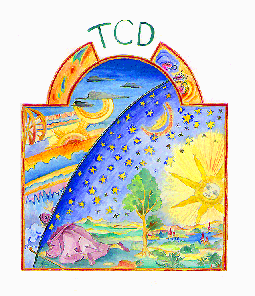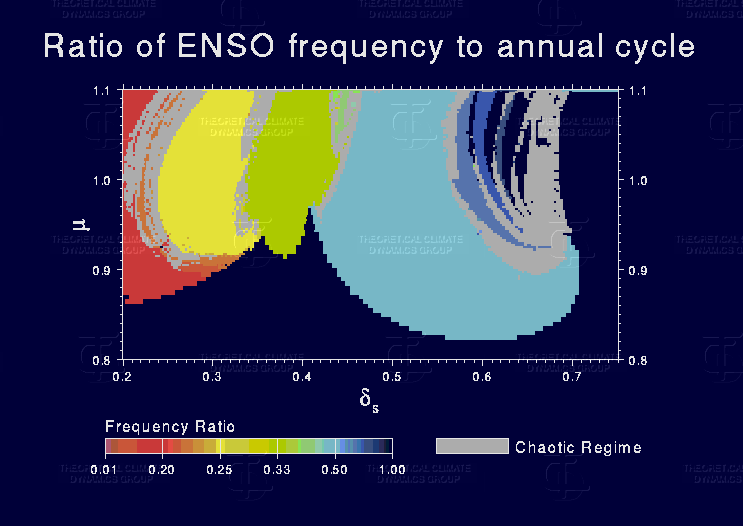 |
|
|
 |
Data Assim. |
Low-Freq. Variability |
Stats. & Prediction |
3-D Ocean |
Physical Processes |
Dynamical Systems |
Atmosphere-ocean interactions are an important factor in
the Earth's climate system. They take place on a wide range of
spatial and temporal scales.
In the tropical Pacific, the interaction leads to the
well-known
El Niño / Southern Oscillation (ENSO)
phenomenon,
whose behavior exhibits both regular and irregular aspects.
We study this highly nonlinear atmosphere-ocean system in terms of
observations, theories, and models; estimate the
coupling parameters;
and carry out experimental forecasts.
For more details of the phenomenon, please see
NOAA El Niño Theme page.
ENSO and the seasonal cycle
 Modeling ENSO has a long history (Philander, 1990;
Neelin et al., 1994).
Introducing seasonal variability into the
Neelin-Jin model
(Jin and Neelin, 1993; Neelin and Jin, 1993) helps
one understand both ENSO's regularity
(locking of warm events to boreal winter)
and irregularity (occurrence of major warmings every 1--10 years).
Rich variability arises from the interaction of the seasonal
forcing and an intrinsic ocean-atmosphere instability,
present already in annually averaged models.
Dynamical systems theory
provides powerful tools to help understand the system's governing mechanisms and parameter dependence.
In the figure, regimes of subharmonic, frequency-locked, and chaotic solutions are shown in the plane of the coupling
parameter and a subsurface flow parameter that determines
the model's intrinsic ENSO period. Blank areas represent regions where no interannual signal is present. Color scale represents the frequency ratio of the interannual oscillation
to the annual cycle in regimes that are frequency locked; e.g.,
0.22 indicates two ENSO cycles every nine years.
Chaotic regimes are indicated in grey, regardless of what spectral
peaks emerge from their broad spectral background figure (from
Jin et al., 1996).
Modeling ENSO has a long history (Philander, 1990;
Neelin et al., 1994).
Introducing seasonal variability into the
Neelin-Jin model
(Jin and Neelin, 1993; Neelin and Jin, 1993) helps
one understand both ENSO's regularity
(locking of warm events to boreal winter)
and irregularity (occurrence of major warmings every 1--10 years).
Rich variability arises from the interaction of the seasonal
forcing and an intrinsic ocean-atmosphere instability,
present already in annually averaged models.
Dynamical systems theory
provides powerful tools to help understand the system's governing mechanisms and parameter dependence.
In the figure, regimes of subharmonic, frequency-locked, and chaotic solutions are shown in the plane of the coupling
parameter and a subsurface flow parameter that determines
the model's intrinsic ENSO period. Blank areas represent regions where no interannual signal is present. Color scale represents the frequency ratio of the interannual oscillation
to the annual cycle in regimes that are frequency locked; e.g.,
0.22 indicates two ENSO cycles every nine years.
Chaotic regimes are indicated in grey, regardless of what spectral
peaks emerge from their broad spectral background figure (from
Jin et al., 1996).
Forecast of Niño-3
In the September 1997 issue of the
National Oceanic and Atmospheric
Administration's
Experimental Long-Lead Forecast Bulletin,
A. Saunders M. Ghil
D. Neelin used
an autoregressive process using singular spectrum
analysis (SSA), multi-channel SSA (M-SSA), and the maximum
entropy method (MEM). The forecast is up to
one year ahead, based on the last 47 years of observed data.
for the forecasts of
equatorial Pacific sea-surface temperature (SST) anomalies
(SSTAs).
More detailed information on the forecast
method based on single-channel SSA combined with MEM is
given by Keppenne and Ghil (1992), while multi-channel SSA
(M-SSA: Kimoto et al. 1991; Keppenne and Ghil 1993; Plaut
and Vautard 1994) combined with MEM is documented in the
March 1995 issue of this Bulletin (see also Jiang et al.
1995).
Figure 1 shows area-averaged Nino-3 SSTAs, forecast and
observed, since 1990, using the SSA- and MSSA-MEM schemes
for a 3-, 6-, 9- and 12-month lead.
The skill in our method is based on the low-frequency, oscillatory components
of the system, and so forecasts tend to filter out short-lived from longer-term
anomalies. According to the current and immediate-past predictions, the
observed sharp rise of SST anomalies over the last few months does not
foretell an El Nino of unprecedented magnitude; it is associated, in all
likelihood, with a short-lived spike asuperimposed on an ENSO event of
typical magnitude.
Figure 3 shows
the SSA-MEM forecast for the SOI from August 1997 through
January 1998. The SOI is expected to stay well below its mean through the
middle
of 1998. The anticorrelation between the present SOI and Nino-3 SSTA
indicates higher predictability (Ghil and Jiang 1997), thus enhancing our
confidence in the forecast.
It is a great pleasure to thank Ning Jiang for her contributions to these
forecasts in the past and wish her well in her new endeavors to forecast the even less
predictable financial indicators.
Further information is available in the
Department of Atmospheric Sciences brochure.
TCD Members:
M. Ghil,
A.W. Robertson, A. Saunders,
W.M. Weibel.
Collaborator at
UCLA:
J.D. Neelin.
References:
Climate Research Committee (E. J. Barron, D. S. Battisti, B. A.
Boville, K. Bryan, G. F. Carrier, R. D. Cess, R. E. Davis, M. Ghil, M. M.
Hall, T. R. Karl, J. T. Kiehl, D. G. Martinson, C. L. Parkinson, B.
Saltzman, R. P. Turco), 1994: Global Ocean-Atmosphere-
Land System (GOALS) for Predicting Seasonal-to-Interannual
Climate, National
Academy Press, Washington, D.C., 103 pp.
Hao, Z., and M. Ghil, 1994: Data assimilation in a simple tropical
ocean model with wind-stress errors, J. Phys. Oceanogr., 24,
2111-2128.
Hao, Z., and M. Ghil, 1995: Sequential parameter estimation for a coupled ocean-atmosphere model. In Proc. 2nd WMO Int'l Symp. on Assim. of Obs. in Meteor. & Oceanogr., Tokyo, March 1995, WMO/TD-No. 651, PWPR Report Series No. 5, WMO Geneva, Switzerland, Vol. I, pp. 181-186.
Jiang, N., M. Ghil and D. Neelin, 1995: Forecasts of
equatorial Pacific SST anomalies by using an autoregressive process and
singular spectrum analysis. Experimental Long-Lead Forecast
Bulletin, Vol. 4, No. 1, pp. 24-27, and Vol. 4, No. 2, pp. 35-36,
National Meteorological Center, NOAA, U.S. Department of Commerce.
Jiang, N., C. Keppenne, M. Ghil and D. Neelin, 1995: Forecasts for
tropical Pacific SST anomalies and the SOI based on singular spectrum
analysis combined with the maximum entropy method. Experimental
Long-Lead Forecast Bulletin, Vol. 4, No. 3, pp. 38-40. National
Meteorological Center, NOAA, U.S. Department of Commerce.
Jiang, N., C. Keppenne, M. Ghil and D. Neelin, 1995: Forecasts of
equatorial Pacific SST anomalies based on singular spectrum analysis
combined with the maximum entropy method. Experimental Long-Lead
Forecast Bulletin, Vol. 4, No. 4, 42-43. National Meteorological
Center, NOAA, U.S. Department of Commerce.
Jiang, N., D. Neelin and M. Ghil, 1995: Quasi-quadrennial and
quasi-biennial variability in the equatorial Pacific. Clim.
Dyn., 12, 101-112.
Jiang, N., M. Ghil and D. Neelin, 1996:
Forecasts of Niño 3 SST anomalies and
SOI based on singular spectrum analysis combined with the maximum entropy
method. Experimental Long-Lead Forecast Bulletin,
Vol. 5, Nos. 2-4.
National Meteorological Center, NOAA, U.S. Department of Commerce.
Jin, F.-f., and J. D. Neelin, 1993: Modes of interannual tropical
ocean-atmosphere interaction - a unified view.
Part I: numerical results. J. Atmos. Sci.,
50, 3477-3503.
Jin, F.-f., J. D. Neelin and M. Ghil, 1994: El Niño on the
Devil's Staircase: Annual subharmonic steps to chaos, Science,
264, 70-72.
Jin, F.-F., J. D. Neelin, and M. Ghil, 1996:
El Niño/Southern Oscillation and the
annual cycle: Subharmonic frequency-locking and aperiodicity. Physica D, 98, 442-465.
Keppenne, C. L. and M. Ghil, 1992-1995: Forecasts of the Southern
Oscillation Index Using Singular Spectrum Analysis and the Maximum Entropy
Method. Experimental Long-Lead Forecast Bulletin, Vol. 1, Nos. 1-4,
Vol. 2, Nos. 1-4, Vol. 3, Nos. 1-4, and Vol. 4, Nos. 1 & 2, National
Meteorological Center, NOAA, U.S. Department of Commerce.
Neelin, J. D. and F.-f. Jin, 1993: Modes of interannual tropical
ocean-atmosphere interaction - a unified view.
Part II: Analytical results in the weak-coupling limit.
J. Atmos. Sci.,
50, 3504-3522.
Neelin, J. D., M. Latif, and F.-f. Jin, 1994:
Dynamics of coupled ocean-atmosphere models: the tropical
problem. Ann. Rev. Fluid Mech.,
26, 617-659.
Neelin, J. D., M. Latif, M. A. F. Allaart, M. A. Cane, U. Cubasch, W.
L. Gates, P. R. Gent, M. Ghil, C. Gordon, N. C. Lau, C. R. Mechoso, G. A.
Meehl, J. M. Oberhuber, S. G. H. Philander, P. S. Schopf, K. R. Sperber, A.
Sterl, T. Tokioka, J. Tribbia, and S. E. Zebiak, 1992: Tropical air-sea
interaction in general circulation models, Climate Dyn., 7,
73-104.
Philander, S. G. H., 1990:
El Niño, La Niña and the Southern Oscillation.
Academic Press, San Diego, 293 pp.
Robertson, A. W., C.-C. Ma, C. R. Mechoso, and M. Ghil, 1995a:
Simulation of the Tropical-Pacific climate with a coupled ocean-atmosphere
general circulation model. Part I: The seasonal cycle, J. Climate,
8, 1178-1198.
Robertson, A. W., C.-C. Ma, M. Ghil, and C. R. Mechoso, 1995b:
Simulation of the Tropical-Pacific climate with a coupled ocean-atmosphere
general circulation model. Part II: Interannual variability, J.
Climate, 8, 1199-1216.
Unal, Y. S., and M. Ghil, 1995: Interannual and interdecadal
oscillation patterns in sea level, Climate Dyn., 11,
255-278.